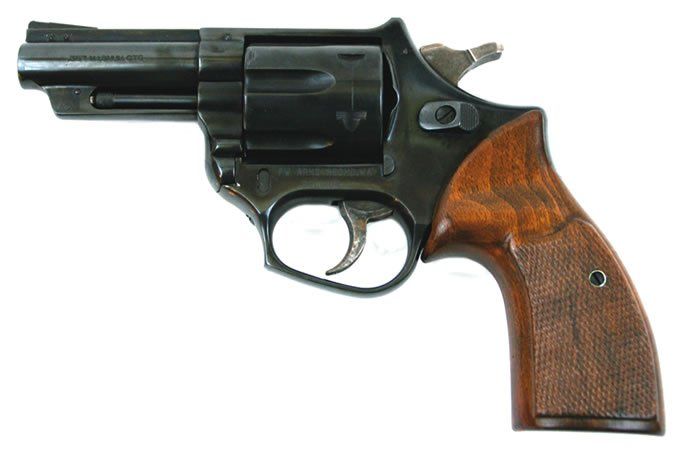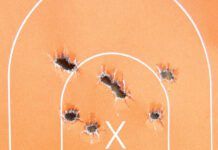The 357 Magnum has an excellent reputation as a defensive round. On medium-sized game like whitetail deer at modest distances, it is effective as well. The round has been around since 1934; General George Patton carried an ivory-handled S&W 357 Mag during WWII. It is a versatile cartridge with many bullet types offered by a variety of manufacturers. Plus, 38 Special ammo in standard and +P loadings can be used in a 357 Magnum as a low-recoil alternative when training or plinking. We wanted to see if we could find a bargain in a full-size revolver with a 4-inch barrel that we could use for personal protection, and we came across two such contenders, a Smith & Wesson Model 19-4 that rated about 90 to 95 percent and a Colt Trooper MK III that rated 80 to 90 percent. Both featured 4-inch barrels, adjustable sights, and wood grips. We also came across an uncommon choice in this chambering, an FN Barracuda, available in the 1970s on a limited basis. It is unique due to the availability of an interchangeable cylinder, which could be switched between 9mm Luger and 357 Magnum. Here’s more about these interesting and affordable choices, along with our recommendations.

Colt Trooper MK III 357 Magnum, $600+
The Trooper was first introduced in 1953, with the MK III variant debuting in 1969. The Trooper MK III tested was produced in 1970 and was a design meant to be more cost effective to manufacture compared to other Colt models like the Python. The MK III uses Colt’s J-frame and a transfer-bar safety mechanism that required the trigger to be completely pulled for the hammer to hit the firing pin, which was built into the frame. The firing pin would then hit the cartridge primer to fire the round. The MK III also used coiled springs, a departure from the flat springs used in Colt’s other SA and DA revolvers.
The Colt sported a gorgeous deep-blued finish with a case-hardened hammer. The trigger was wide and grooved more coarsely than the Model 19. The hammer spur was also wide and nicely checkered. The grip was similar looking to the Smith’s Magna grip, but the Colt’s were slimmer, like the FN, making the gun feel less fat in hand compared to the Model 19. A gold-plated Colt medallion was inset in the grips. The butt did not flare out like on the Model 19, and some testers preferred the Colt’s grip.
The top strap and top of the barrel had a matte finish to diminish glare. The front ramp sight was serrated to further diminish glare, and it was pinned in place so it could be replaced. The Model 19’s front sight was machined as part of the barrel. The rear sight was adjustable for windage and elevation, and the direction marks were clearly indicated, unlike the Smith’s. Testers tended to slightly prefer the Smith’s sights to the Colt’s, but noted the Colt’s sights were what was expected in a modern handgun.
The cylinder latch was rounded yet provided a good grip to pull on, though most testers felt the S&W-style push-latch was more natural. The ejector rod was enclosed in an under lug that went halfway up the barrel, just like the M19. From the initial look, the Colt tfelt tight, but as we continued checking out the Colt, we saw a few red flags.
When we slowly cocked the hammer for single action, we noticed the cylinder did not completely rotate and the cylinder bolt did not snap into the bolt slot in the cylinder. We needed to ever so slightly rotate the cylinder so the bolt would lock into the cylinder. Not good. When we smartly cocked the hammer we did not have this issue, nor did we have the issue when dry firing in double action. Our first thought was that the hand was off. The second red flag was when we looked at the recoil shield of the frame with the cylinder swung open. We could see that the ratchet had peened the frame, leaving a slight star-like impression. We could also see where the base of cartridges left marks in the bluing, clearly showing the cartridge base and primer. This indicated to us that the previous user had fired hot high-pressure loads in the Colt. We also noticed that one of the sideplate screws was buggered. Someone had opened up the Colt, and that made us suspicious. We flushed out the 44 years worth of old lubricant with Gunslick Gun Flush. Grit dripped and cleaner ran out, and we flushed it until it ran clean. That took care of the cylinder locking issue when the hammer slowly cocked.
When we called Colt about servicing, there was an initial charge of $150 to $200 to examine the piece and determine the next steps. That would increase the price of the revolver substantially, and the team felt that was more than they wanted to spend.
We tested the Colt with the standard range rod, and it passed. Using a Clymer GO headspace gauge, we checked each chamber and discovered that the Colt was within spec. The Colt has a rebated cylinder, which means it is recessed to allow the rim of the cartridge to almost touch the frame at the rear of the cylinder. Revolvers with non-rebated cylinders, when viewed from the side, the case rim can be seen. The S&W and FN had recessed chambers, so the cartridge sat flush with the rear of the cylinder. When the cylinder of the Trooper was opened and closed, we noted there was no binding, and the same when cocking or dry firing in DA. After our inspection, we determined the Colt was safe to shoot, albeit the Colt had seen some service and uncouth tinkering.
The Colt had big sights that were easy to pick up, and in DA, the trigger pull was smooth. Accuracy was on par with the other two revolvers.
Our Team Said: The Colt had issues from past hard use, suggesting that we pass on this particular revolver. If we were to buy this revolver, we would definitely send it back to Colt for servicing. But we wouldn’t buy one in this condition.

The Model 19-4 was the fourth engineering design change to the Model 19, hence the “-4” nomenclature. This revolver was derived from the 357 Combat Magnum first produced in 1957 and then later designated the Model 19. Bill Jordan, the U.S. Border Patrol officer, noted fast-draw shooter, and gun scribe, helped convince S&W to build a 357 Magnum on a K-frame. Jordan thought the set up would be perfect for law-enforcement use. Previous 357s were built on the larger and heavier N-frame.
The Model 19 proved to be a success in LE circles and with civilians. The Model 19 was discontinued in 1999, but its DNA lives on in the Model 66, which is an updated stainless-steel version.
The Model 19-4 we tested was built between 1978 and 1979 and wore a nickel-plated finish with a casehardened trigger and hammer. Some did not care for the nickel finish. The trigger was wide and grooved, while the hammer spur was wide and checkered. It sported S&W’s signature Magna checkered wood grips that fill the space behind the trigger guard and provided a hand-filling grip. The grip flared out at the butt. Testers were split on the grips — some liked the grips, others not so much. Some felt they were too big and did not absorb recoil as well as modern-day rubber grips. The left grip was scooped out where a right-handed shooter’s thumb would fall to allow use of speedloaders. Nickel-plated S&W medallions were inset into each of the wood stocks. The serrated backstrap was exposed between the grip halves, and some shooters said there was more felt recoil than with softer, rubber grips.
The sighting plane was matte nickel with long grooves along the top strap and barrel to kill glare. The ramp front sight was also serrated, which lessened glare as well. The rear sight was matte blue and adjustable for windage and elevation. The bottom part of the rear sight was also serrated, which also helped reduce glare. Testers liked the sights. Our shooters had no complaints with the sights or the trigger in either double or single action. It was smooth and crisp — exactly what shooters expected from an S&W revolver.
The Model 19 had a full-size cylinder latch that was simple to operate and securely locked the cylinder in place or allowed it to swing free with a push of the latch. The ejector rod mated with a pin in the barrel under lug, adding another locking point for the cylinder. This old Smith was tight. The chambers in the cylinder were countersunk so cartridges fit flush with the rear of the cylinder.
The Smith had a safety built into the mechanism that blocks the hammer. That safety would not allow the firing pin to hit a cartridge primer unless the trigger was pressed. Also, the trigger cannot be cocked when the cylinder is swung out for loading.
All our checks — range rod, headspace gauge, and visuals — indicated that the Smith had not been fired often. We did note there was a nick near the muzzle, but that ding was on the outside edge, not near the rifling.
If it had been near the rifling, we’d be suspect that the dent would affect accuracy. At the range, we fed the revolver 38 Special +P and 357 Magnum ammo. Testers liked how the Model 19 handled. They felt the revolver was a good weight, even with hot 357 Mag rounds. Some stated they would swap the Magna grips for aftermarket rubber ones. Accuracy was adequate, nothing special, about what we have come to expect from 357s.
Our Team Said: The Model 19 would make a good defense gun, but most would prefer a blued version, since the nickel sparkled even in dim light. Hunters in the group said they would use it for whitetails at bow-hunting distances. All agreed that it had a good trigger, and everyone said this is a handgun they would definitely buy if they located one in good condition.

FN Barracuda 357 Magnum, $450-$750
The Barracuda was an attempt at FN to get into the law-enforcement market in the 1970s. At that time, LE was already looking into semi-automatic pistols, so this revolver didn’t have a problem to solve. What the Barracuda offered over what the Colt and S&W was a quick-change cylinder. Two cylinders were available, one chambered in 357 Magnum and one in 9mm. The 9mm cylinder required use of moon clips. Our test revolver did not come with the extra cylinder, and testers felt that was a pity as it would make the revolver more useful and therefore more valuable in their eyes. The Barracuda passed the range-rod test with a standard size head. There was some wiggle in the cylinder.
The FN had a nice deep-blue finish. A slight drag mark was noted on the cylinder. The finish on the chunky hammer and trigger was casehardened. Both the trigger and hammer were serrated for a sure grip.
A 3-inch barrel with fixed sights came on the Barracuda. The metal around the rear sight was built up, so it felt and looked like it was adjustable. With the added metal, we thought FN should have included an adjustable rear sight. A notch on the side of the rear sight and the ramp could hold a dab of white paint to make the sights stand out more. The top of the frame and barrel were serrated. The front of the trigger was squared off like on a SIG or Beretta semi-auto pistol, but this was more aesthetic than practical. The grip was similar in feel to the Colt and smaller than the Model 19.
To open the cylinder, the shooter pushed the cylinder latch forward like on the S&W. It locked up in the rear, where the extractor pin fits into the rear of the frame. At the front of the ejector rod, there was a hole for a pin in the ejector shroud to snap into. With the cylinder open, a button screw on the right side of the frame could be pressed to remove the cylinder and crane assembly. The FN had a sideplate on the right side.
The FN felt good in the hand and felt heavier than it looked.
Testers said felt recoil was manageable with the Barracuda, and it was as accurate as the Smith and Colt. Testers noted they could hold high on the grip, so the pistol was manageable even in rapid DA. Like the other revolvers, the full-length ejector rod spewed out empty cases with ease.
Our Team Said: The Barracuda performed well, but the lack of aftermarket parts and not having the 9mm cylinder knocked this revolver down a half point. All agreed the trigger was serviceable, and it looked like the revolver was built to last.
Written and photographed by Robert Sadowski, using evaluations from Gun Tests team testers.
GUN_TESTS_VALUE_GUIDE_4-INCH_357_MAGNUM_REVOLVERS.pdf

















